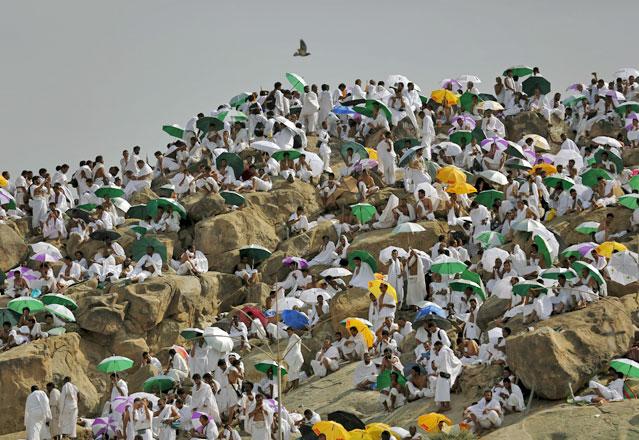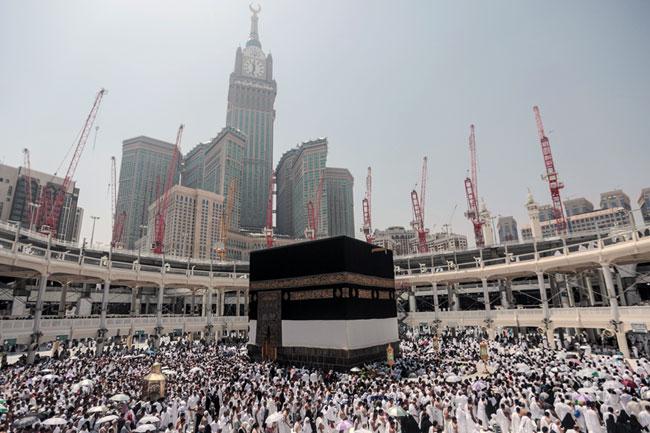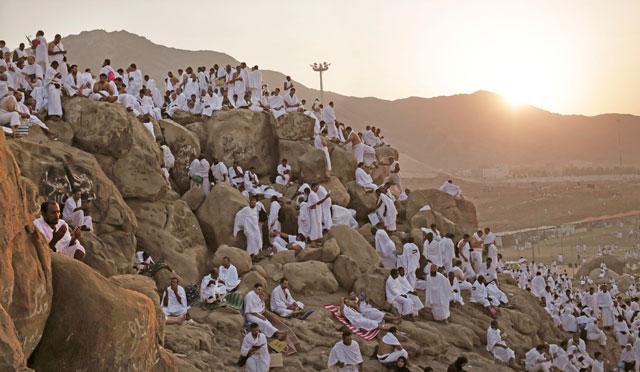You are here
Pilgrims throng Arafat for peak of Hajj
By AFP - Sep 23,2015 - Last updated at Sep 23,2015

Pilgrims pray on Mount of Mercy on the plains of Arafat during the annual Hajj, outside the holy city of Mecca, on Wednesday (Reuters photo by Ahmad Masood)
MOUNT ARAFAT, Saudi Arabia — Around two million Muslims on Wednesday poured into the vast Saudi plain where Prophet Mohammad is believed to have given his final sermon, for the peak of the Hajj, the greater Muslim pilgrimage to Mecca.
Many of the faithful from around the globe camped at the foot of Mount Arafat where they slept, exhausted from their journey, and prayed despite the scorching sun.
Carrying colourful umbrellas, they walked from dawn in massive crowds towards the 300-metre-high slippery, rocky hill — also known as Mount of Mercy — located on the plain.
Here they believe Prophet Mohammad gave his last sermon 14 centuries ago after leading his followers on Hajj.
Unlike previous years, the pilgrims were not carrying their countries' flags, in what local media said was a "ban" on flags during the pilgrimage.
The kingdom's authorities have repeatedly warned against the use of any political slogans or banners during Hajj.
To organise the flow of pilgrims, security forces formed human chains along the roads, while volunteers handed out boxes of food and cold water bottles.
The faithful gathered in their hundreds of thousands for noon prayers, as water sprays were turned on to cool them down while helicopters hovered overhead.
For many pilgrims, Hajj is the spiritual highlight of their lives.
"We feel blessed. I got goosebumps, a feeling that cannot be explained, when reaching the top of the mountain," said Ruhaima Emma, a 26-year-old Filipina pilgrim, who said she has been "praying for a good life for everyone".
For Akram Ghannam, 45, from war-torn Syria, being in Arafat is a "feeling that cannot be described. I pray to God for the victory of all those who are oppressed".
Many reached Arafat by bus while some walked from the holy city of Mecca about 15 kilometres away.
Other pilgrims arrived from nearby Mina using the elevated Mashair Railway linking the holy sites of Arafat, Muzdalifah and Mina, a tent city where many pilgrims spent Tuesday night.
No major incidents were reported on Arafat but the civil defence agency announced that there were more than 200 cases of “fainting and fatigue” after doors failed to operate at one of the railway stations, causing crowding.
After sunset on Wednesday the faithful will move to Muzdalifah. There, they will gather pebbles for a symbolic stoning of the devil ritual on Thursday, which is also the Eid Al Adha feast of sacrifice marked by the world’s more than 1.5 billion Muslims.
Seeking ‘mercy’
This year’s gathering is about the same size as last year’s, with 1.4 million foreign pilgrims joining hundreds of thousands of Saudis and residents of the kingdom.
They are undeterred by a construction crane collapse at Mecca’s Grand Mosque earlier this month that killed 109 people, including foreign pilgrims.
About 400 people were injured by the crane which was working on an expansion of Islam’s holiest site.
Previously marred by stampedes and fires that killed hundreds, the pilgrimage had been largely incident-free for the past nine years after safety improvements.
The Hajj is among the five pillars of Islam and every capable Muslim must perform it at least once in a lifetime.
This year’s gathering takes place against a backdrop of increased jihadist violence in some Muslim countries, a surge of the potentially deadly MERS virus and the war in Saudi Arabia’s neighbour Yemen.
About 100,000 police have been deployed to secure pilgrimage sites and manage the crowds.
Authorities say they are on alert for possible attacks by extremists, after Daesh militatns bombed security forces and Shiite mosques in the kingdom in recent months.
This year’s Hajj also comes with Saudi Arabia leading an Arab coalition conducting air strikes and supporting local forces in Yemen against Iran-backed rebels.
Most Yemeni pilgrims performing the Hajj this year already reside in the kingdom.
Among other challenges facing Saudi authorities is potential transmission of the deadly Middle East Respiratory Syndrome coronavirus (MERS-CoV).
The capital saw a jump in infections last month, but health officials say there has never been a case of MERS infection among pilgrims.
The health ministry has mobilised thousands of medical workers to help ensure a virus-free pilgrimage and to care for routine ailments.
Pilgrims began the Hajj on Tuesday by entering ihram, a state of purity in which they must not quarrel, wear perfume, or cut their nails or hair.
During ihram, men wear a seamless two-piece shroud-like white garment, while women must wear loose dresses, generally also white, exposing only their faces and hands.
The clothing emphasises their unity, regardless of whether they spend the Hajj in Mecca’s five-star hotels or in shabby highrise hostels.
“I’m hoping for mercy and that Allah accepts our prayers,” said Pakistani pilgrim Abdeghafour Abu Bakr, 38, who came with friends.
Related Articles
MECCA — Hundreds of thousands of Muslims from across the globe began the annual Hajj, the greater Muslim pilgrimage to Mecca, on Tuesday in
MOUNT ARAFAT — The Hajj reached its high point Sunday when Muslims from across the world converged on a stony hill in Saudi Arabia, a year a
MECCA — Mask-clad Muslims began the Hajj on Wednesday, circling Islam's holiest site along socially distanced paths in the smallest pilgrima














